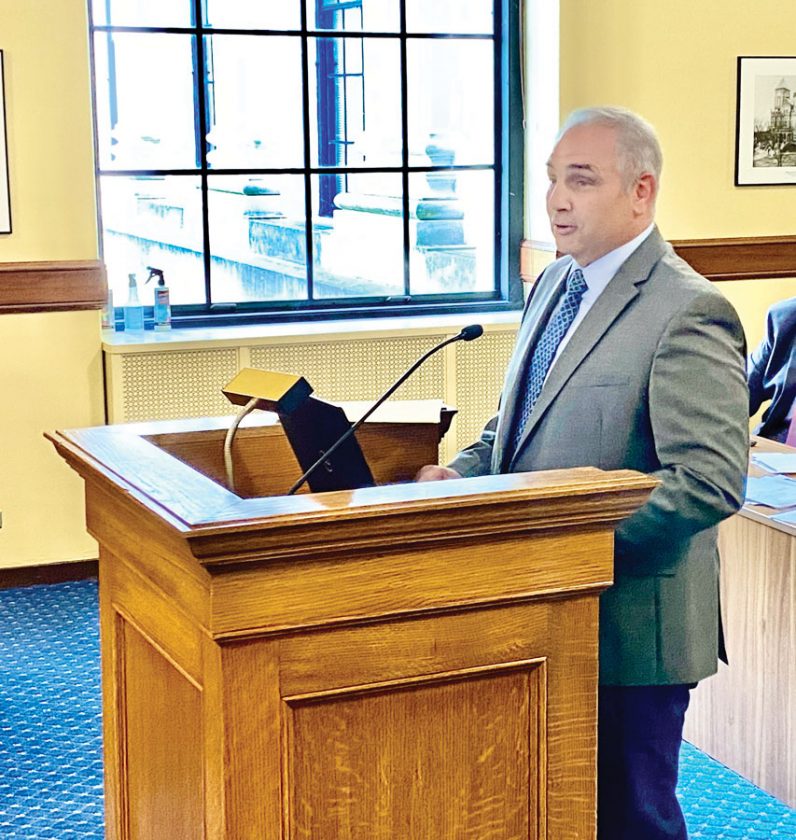Swope: Flood mitigation a priority for infrastructure dollars

Bob Martin, director of the State Resiliency Office, briefs the Joint Committee on Flooding Sunday about its two-day flood symposium in May with the Pew Charitable Trusts. (Photo by Steven Allen Adams)
CHARLESTON — All of the millions of dollars available from last year’s COVID-19 recovery bill that can be used for certain infrastructure projects, State Sen. Chandler Swope — the co-leader of the Joint Committee on Flooding — said lawmakers need to focus on flood mitigation. The Joint Flooding Committee met Sunday afternoon on the first day of three-day legislative interim meetings at the State Capitol Building. Swope, R-Mercer, asked committee members to support calling on the Legislature to add flood mitigation to the list of subject matter it develops legislation for now that federal funds are available for potential projects. “I’m suggesting that the Legislature as a whole add flood mitigation to its infrastructure categories of subjects to review or to discuss and hopefully find funding for,” Swope said. “We currently have highways, water lines, water systems, wastewater, and broadband, but I feel like flood mitigation has been ignored over the years, mostly because we didn’t have any money. There wasn’t funding. Now, there’s lots of federal funding available.” West Virginia received the second tranche last month of $1.35 billion in direct state funding from the federal American Rescue Plan Act. The funds can be used for coronavirus-related expenses, but the funds can also be used for specific infrastructure projects, such as broadband, stormwater, and watershed infrastructure projects, including flood mitigation. West Virginia is expected to receive between $6 billion and $7 billion over the next several years from the $1.2 trillion Infrastructure Investment and Jobs Act, some of which can be used for flood mitigation and stormwater infrastructure projects. Plus, West Virginia is expected to end the fiscal year at the end of June with more than $1.1 billion in tax revenue surplus. Once items included in the new fiscal year general revenue budget to be funded by surplus are paid out, the state will have a sizable amount of surplus funds to use for projects. Last month, Swope along with state and local emergency management officials took part in a two-day flood symposium sponsored by the Pew Charitable Trusts, New Orleans-based disaster recovery and mitigation company SBP, and the State Resiliency Office. Bob Martin, director of the State Resiliency Office, said that Pew is compiling the data collected from participants at the symposium. The goal of the symposium was to review and update West Virginia’s flood protection plan, an 11-page document first completed in 2004. Martin said the review should be completed by the end of the year. “By the end of the year we’ll have a review of that plan done,” Martin said. “We’ve already identified a lot of the things that are within that plan that have already been either done or partially done, and some…that are no longer even relevant because of the fact of technology has kind of bypassed the idea of where they were.” Attendees at the symposium heard from Christopher Emrich, an endowed associate professor of Environmental Science and Public Administration at the University of Central Florida. Emrich was part of a team of researchers who developed a tool called HazardAware, which can determine flood and storm risks. Using that data, emergency planners can see where the risks are and deploy flood mitigation resources to those areas. “It takes about 50 different criteria and analyzes the probability of flooding in any specific location anywhere in the state,” Swope said. “That algorithm’s been run, and we now have a database of GIS analysis that identifies the largest flood risk areas in all the streams in the entire state. The reason I believe this is important is that flood mitigation, according to the federal government’s official opinion, is that every dollar spent on flood mitigation yields $6 in savings from flood losses.” Flood Committee members also heard a report on the RISE West Virginia 2016 flood recovery program and the state’s Community Development Block Grant-Mitigation (SBGB-MIT) program, both funded by the U.S. Department of Housing and Urban Development. As of June 1, RISE has constructed 367 houses, 46 bridges, and completed 54 demolitions in areas affected by the 2016 1,000-year flood event in part of Southern West Virginia. Of the $149.9 million in federal RISE funding, $90.7 million has been spent. Of those 367 houses completed, 22 percent are out of flood plain and insured. According to a June 1 HUD report, the state was labeled a “slow spender” again for the pace of the RISE program. States receive a “slow spender” designation when they spend less than 10 percent of the monthly pace required to fully use the grant by the grant’s target closeout. Jennifer Ferrell, the RISE program director for the West Virginia Development Office, told committee members that 20 homes and eight bridges remain to be constructed, with 12 of those homes under construction now and eight in the acquisition phase. RISE expects all remaining projects to be completed by the end of the year. The RISE program first began in 2018 and has been plagued with issues, resulting in the West Virginia National Guard running the program for a few years. RISE officials confirmed that the program is under an ongoing state and federal investigation. As for the CBGB MIT, out of the $106.5 million awarded the state by HUD on Jan. 13, 2021, the program has received 37 applications, with 18 projects awarded at a cost of $65 million, with $40 million being spent in areas with low to moderate income in Clay, Greenbrier, Kanawha, Nicholas, Fayette, Jackson, Lincoln, Monroe, Pocahontas, Roane, Summers, and Webster counties. The application deadline for the second round of CDBG-MIT projects is June 30. More than $41 million in CDBG-MIT funding remains. Steven Allen Adams can be reached at sadams@newsandsentinel.com





